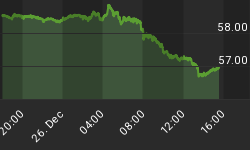A few weeks ago we wrote about the true cause of hyperinflation, which is a major break or failure in the bond market. It has nothing to do with demand, bank lending or the velocity of money as many have suggested. It is a confidence issue. It is not a rise in inflationary expectations but a loss of confidence in a country being able to repay its debts. As confidence is lost, interest rates rise. Monetization occurs when the cost of servicing the debt consumes too much of the overall budget, so that the government can't provide basic services or loses its ability to function on a day-to-day basis.
The important point to note is that deflationary forces lead to hyperinflation. Once again, it is not demand, bank lending or increased velocity. Those things do not trigger severe inflation; they merely can be a symptom after the trigger. And by the way, increased velocity is basically another form of increased demand. Fundamentally, they are no different.
Is anyone paying attention to the first domino in the sovereign debt crisis? Take a look at this Bloomberg Story: http://www.bloomberg.com/apps/news?pid=20601087&sid=awXzaHHx8T6M
Iceland's Economy Shrinks 8% as Prices rise by 11%. Deflationary forces are causing severe inflation, as Iceland's government is bankrupt. Moreover, bank lending in both the US and the UK has been sliding, yet we see price inflation increasing in the UK and starting to pickup in the US. Even amidst deflation in the private sector, Gold has risen to an all time high against both the Dollar and the Pound and also the Euro.
The deflationists have it backwards. As we've illustrated, severe deflation is what leads to hyperinflation. Debt crisis' go hand in hand with currency crises. In fact, if we had an increase in bank lending, consumption and velocity, we'd be assured we wouldn't have hyperinflation. We'd end up with rising price inflation for certain, but not hyperinflation. Hyperinflation has never occurred at a time of strong or growing demand.
So what is the real debate then?
The debate and discussion should be about the bond market. If one were against the hyperinflation scenario, then they would have to think the bond market is going to hold up. If one believes we will see severe inflation then they have to believe in a major break in the bond market. We don't believe in Weimar or Zimbabwe style hyperinflation. That is just too extreme. We do believe that we will see severe inflation worldwide as a result of a loss of confidence in governments and currencies. Falling bond markets and rising interest rates will reflect this.
For Gold watchers, now is the time to start watching the relationship between Gold and bonds. According to Wikipedia, the worldwide bond market is $82 trillion and the US bond market is $34 trillion. Clearly, the crowded trade is bonds. Gold's bull market will accelerate when money starts to move out of bonds and into Gold.
First let's take a look at a Gold/Bonds ratio. This is Gold against the Barclays Corporate Bond Index. Against stocks, Gold us up more than five-fold, yet against this bond index, Gold is up less than three fold.

Here we show Gold against the Dow Jones Corporate Bond Index, which is a total return index. Gold has broken past its 2008 peak against literally everything except the Yen and Corporate Bonds.

A breakout in this ratio will be very significant for global capital markets. If and when we see Gold breakout against Corporate Bonds, it will be a major signal that inflationary expectations are increasing. Moreover, it should be a major catalyst for Gold as the fixed income markets dwarf the tiny Gold market.
For more analysis like this and complete coverage of Gold and Silver stocks, consider a free 14-day trial to our premium service.
















